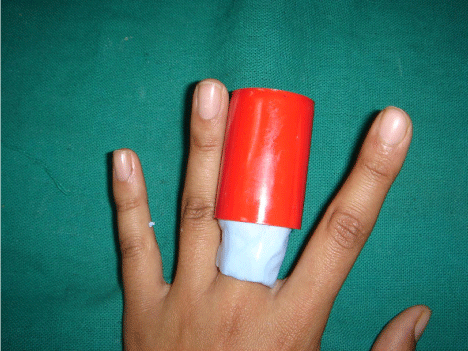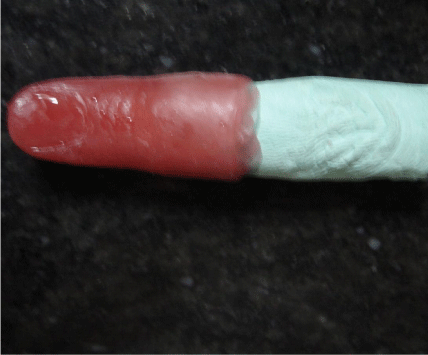Abstract
Anaplastology is a branch of medicine dealing with the prosthetic rehabilitation of an absent, disfigured or malformed facial or body parts. The custom-made finger prosthesis is esthetically acceptable and comfortable for use in patients with amputated fingers, resulting in psychological improvement and personality. The success of the any prosthesis depends on the precision of planning the prosthesis, making the impression, wax sculpting and choosing the maxillofacial material that best suits the concerned circumstances. The article describes a simplified, cost effective and modified approach for fabricating thimble –type prosthesis in a case of lost finger tips.
Keywords: Distal finger amputation; Impression cap; Silicon prosthesis; Thimble-type prosthesis
Introduction
Finger and partial finger amputations are frequently encountered problems leading to partial hand loss, which occur commonly due to trauma, congenital absence or malformations. All of these may present similar clinical challenges which can vary from loss of fingertip to complete finger amputation. Frequently, the loss of even the tip of a digit can be so emotionally disturbing to the patient that it deserves serious attention [1]. Creating a life like prosthesis with characteristics such as pleasing shape, thin margins, lifelike fingernails, and realistic color, contours and details are essential for patient satisfaction, but to maintain all these qualities it needs good suspension [2]. Recording a suitable impression of the residual supporting structure is primary requirement for obtaining better fit of the prosthesis.
In the present case reports, successful prosthetic rehabilitation by fabricating thimble-type prosthesis for lost fingertip of middle finger in a young female is discussed.
Case Presentation
A 24-year-old female patient came to the department with the chief complain of loss of upper phalange of the middle finger of left hand due to childhood injury (Figure 1). The patient was more esthetically and socially concerned with no functional problem reported as she was well adapted with time. Remnant of the nail was seen on the tip of amputated part. The distal amputation level was sub zone II as classified by Ishikawa et al [3]. The patient was advised to cut her nail at timely interval, so that it may not affect the fitting of the prosthesis.

Figure 1: Pre-treatment view of the hand.
Procedure
A plastic cylindrical small open container (Impression Cap) [4] was used for making silicone impression of the defected finger (Figure 2). Putty and light body addition silicone impression material (Express, 3M ESPE; St. Paul, MN) was used and after that cast was poured. The wax pattern was made using alginate impression (Zelgan, Dentsply India Pvt. Ltd.) of the same fingers of right hand. For alginate impression, vent holes were made in the impression cap for retention and easy escape way of the alginate material. Molten modeling wax (Y- Dents, MDM Corporation, New Delhi, India) was poured in alginate impression and after cooling of wax, minor modification of the pattern was done to simulate it according to the fingers of left hand. Wax pattern was modified and terminated till next joint of the missing finger as margins were least visible at joint area. This pattern closely resembles the shape and size of the missing finger and after hollowing with the hot wax spatula this pattern was properly fitted over the cast (Figure 3). After taking final opinion of the patient pattern was flasked for curing with silicone material (bredent Multisil-Epithetic set, Senden, Germany). Care was taken to avoid undercuts during counter- flasking. The pattern was flasked in such a way that dorsal and the ventral aspects of the finger were separable to enhance the accuracy at the stage of shade matching. Suitable quantity of Multisil-Epithetic transparent was first poured onto a mixing pad. Intensive stains were mixed into the epithetic transparent and direct color comparison of the palmer and dorsal surface of the hand were carried out separately in natural day light. After all stains had been mixed, thickener was used to increase viscosity of silicon material to avoid running of the different stains while adding them into the flask. For the characterization of fingernail, palmer surface shade was used to simulate natural nails. After curing the final prosthesis was retrieved, the flash was trimmed using a sharp blade and the final finishing was completed using fine sand paper. Patient was well satisfied with its retention and esthetic appearance (Figure 4). Proper instructions regarding the follow- ups and handling of the prosthesis were given.

Figure 2: Impression of defective finger by using impression cap.

Figure 3: Wax pattern of the thimble prosthesis.

Figure 4: Post-treatment view of the hand.
Discussion
In the present case report, residual nail was present and patient had already informed that it was growing continuously. Patient was not ready for any surgical modification for finger prosthesis. It was thought to timely cut the nail at specific time interval. The nail can be well used as a retentive tool for the prosthesis; also it reduced for further chances of any surgery. The prosthesis can be well fitted in the nail groove and thus advantageous for the prosthesis support.
There are various techniques for impression making described in various literatures [4-8]. Most commonly used technique is alginate impression enclosed in box made up of modeling wax [5]. The impression made in addition silicone involves mixing equal amounts of the base and catalyst on a mixing pad and applying it on the hand with a spatula to a thickness of about 2-3 mm [6]. Silicon can be additionally reinforced with plaster to support the impression material [7]. A box made of modelling wax was also used to make the silicon impression of the finger [8]. In the present case, Impression cap was used for making impression with silicon material [4]. Using impression cap has various advantages over other techniques like- a rigid box for impression making, uniform application of pressure during impression, reduced voids, use of less impression material and recording of tissues within compressible limits [4]. However use of impression cap is limited for recording single digit impression. For recording multiple digit at a time requires customized construction of box.
Wax Pattern, made by using the similar fingers of the other hand was an accurate replica of the missing finger part and it required minimal sculpting, which further reduced the additional time needed for wax pattern sculpting and needed less artistic expertise with acceptable clinical outcome. The total time needed for preparing wax pattern was around 20 to 30 minutes from impression making to final adaptation. The wax pattern prepared through this technique satisfactorily duplicated the original skin surface irregularities and anatomical details, also maintained individuality leading to higher acceptance rate [7].
Preparing thimble prosthesis offers two important advantages over full-length finger prosthesis: firstly it avoids fitting across and thus allows unobstructed mobilization of the proximal inter phalangeal joint; and secondly it minimizes coverage and thus allows maximum sensibility of the intact skin [9]. The proximal edge of the prosthesis is made thin and translucent to achieve a good visual blend with the surrounding skin. Good suspension alone is not sufficient for patient acceptance of finger prostheses and in many cases a high level of cosmoses is paramount. Characteristics such as a pleasing shape, thin margins, lifelike fingernails, and realistic color, contours and detail are essential for patient satisfaction. This level of restoration is most successful when finger prostheses are individually sculpted and colored in situ under a variety of lighting conditions.
Now -a -days, silicone elastomers are the most commonly used materials for fabrication of prostheses [10]. These prostheses provide a cost-effective and cosmetically acceptable means of camouflage for patients who decline or postpone surgical reconstruction [11]. A clear to translucent silicone rubber is compatible with all the intrinsic and extrinsic coloring systems available [12]. Restoring the natural appearance of the hand prosthesis offers functional and rehabilitative advantages as well as psychological satisfaction of the patients by eliminating trauma caused by constant reminder of the handicap [13]. The palmer shade was used for duplicating the nail, which gave the illusion of the natural appearance because the wax replica closely resembled the original finger anatomy [4].
The patient was well satisfied with the treatment during periodic re-evaluation of the prosthesis at 1 month, 3 month and 6month interval. Level of satisfaction was measured using five points Likert’s scales (ranging from “strongly agree” to “strongly disagree”) at the time of delivery and during follow-up visits and it was noticed that patient’s satisfaction scale was improved from level 3 (at the time of insertion) to level 2 (during follow-ups). The patient further told that earlier she faced some problem with function as she was not able to fold the finger for making fist along with feeling awkward sensitivity during various movements and holding some object but later with time she got used to it [14]. Since an adhesive was not required, problems of compliance were reduced.
Conclusion
In cases of distal finger amputations, thimble–type prosthesis is a good option providing effective cosmetic, functional and psychological outcome thus raising self-confidence of the patient.
References
- Leow ME, Prosthetist C, Pho RWH. Optimal circumference reduction of finger models for good prosthetic fit of a thimble-type prosthesis for distal finger amputations. J Rehabil Res Dev. 2001; 38: 273-279.
- Pereira BP, Kour AK, Leow EL, Pho RW. Benefits and use of digital prostheses. J Hand Surg Am. 1996; 2: 222-228.
- Ishikawa K, Ogawa Y, Soeda H, Yoshida Y. A new classification of the amputation level for the distal part of the fingers. J Jpn Soc Microsurg. 1990; 3: 54–62.
- Tripathi S, Singh RD, Chand P, Mishra N, Yadav LK, Singh SV. A modified approach of impression technique for fabrication of finger prostheses. Prosthet Orthot Int. 2012; 36: 121–124.
- Dogra S, Lall S, Shah F, Aeran H. Fabrication of a glove type finger prosthesis using silicone elastomers. J Indian Prosthodont Soc. 2008; 8:165.
- Leow ME, Pho RW. RTV silicone elastomers in hand prosthetics: properties, applications and techniques. Prosthet Orthot Int. 1999; 23: 169-173.
- Leow ME, Kour AK, Ng WK, Pho RW. Creating a model for fabricating a partial hand glove prosthesis using the realigned casts of the contra lateral digits. Prosthet Orthot Int. 1999; 23: 72-74.
- Singhal S, Chand P, Singh SV and Tripathi S. Case report: modifications to simplify fabrication of finger prosthesis: a case series. J Prosthet Orthot. 2011; 23: 30–33.
- Leow ME, Pereira BP, Kour AK, Pho RW. Aesthetic life-like finger and hand prostheses: prosthetic prescription and factors influencing choices. Ann Acad Med Singapore. 1997; 26: 834-839.
- Gunay Y, Kurtoglu C, Atay A, Karayazgan B and Gurbuz CC. Effect of Tulle on the Mechanical Properties Of a maxillofacial silicone elastomer. Dent Mater J. 2008; 27: 775-779.
- Butler DF, Gion GG, Rapini RP. Silicone auricular prosthesis. J Am Acad Dermatol. 2000; 43: 687–690.
- Seals RR Jr, Cortes AL, Funk JJ, Parel SM. Microwave techniques for fabrication of provisional facial prostheses. J Prosthet Dent. 1989; 62: 327- 331.
- Pillet J. Esthetic hand prostheses. J Hand Surg Am. 1983; 8: 778-781.
- Likert R. A Technique for the Measurement of Attitudes. Archives of Psychology. 1932; 140: 1–55.
